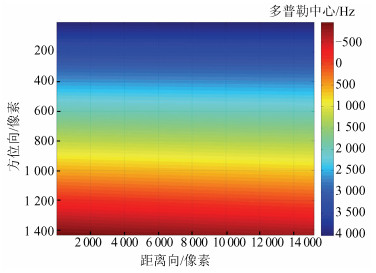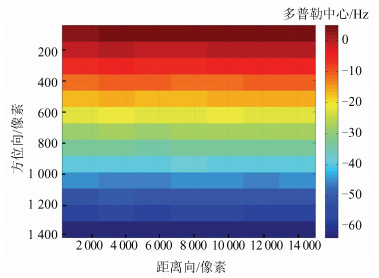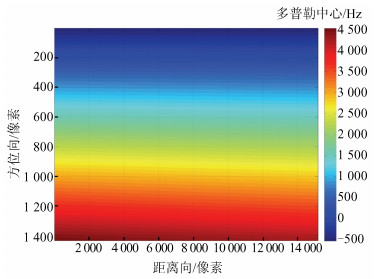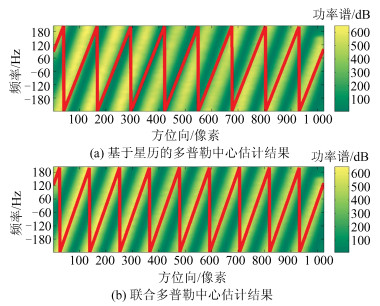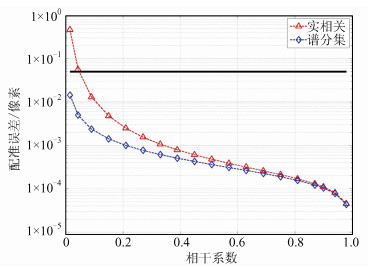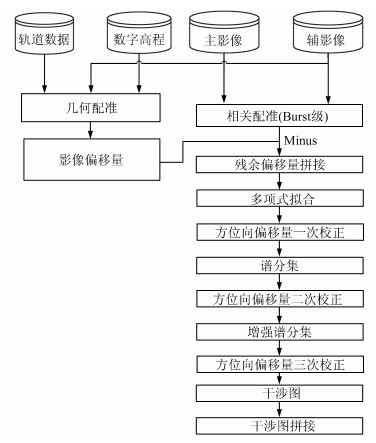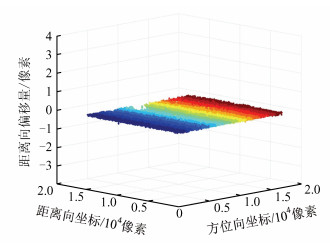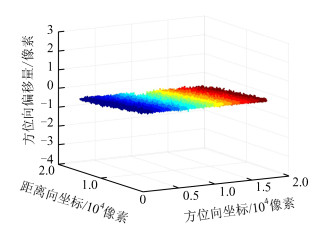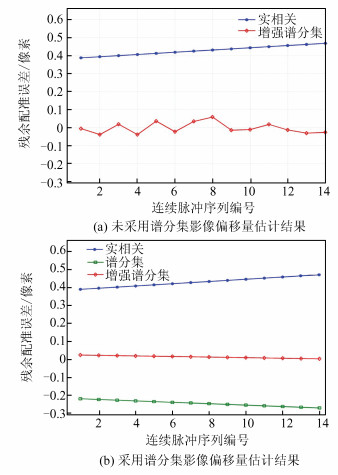-
摘要: 宽幅干涉(terrain observation by progressive scans,TOPS)模式方位向多普勒中心频率的变化导致了干涉图相位的相对扭曲,干涉处理时需要较高的配准精度。加拿大合成孔径雷达遥感卫星(RADARSAT-2)TOPS模式影像由于轨道精度较差,几何配准精度过低,导致其干涉配准较哨兵合成孔径雷达遥感(Sentinel-1)卫星更加复杂。为了实现该卫星TOPS模式影像的干涉处理,首先采用相关配准、谱分集方法依次对几何配准结果进行校正,然后利用增强谱分集进行方位向偏移量矫正。由于依靠卫星星历参数和聚焦成像参数的多普勒中心估计方法精度有限,因此提出了采用相位增量法优化多普勒中心估计结果,并通过影像方位线功率谱检验了估计的多普勒中心。
-
关键词:
- RADARSAT‐2卫星 /
- 宽幅干涉模式 /
- 增强谱分集 /
- 几何配准 /
- 相位增量法
Abstract: The variation of the azimuth to Doppler center frequency of the terrain observation by progressive scans (TOPS) mode leads to the relative distortion of the phase of the interferogram. Therefore, high registration accuracy is required for interference processing. The Canadian Synthetic Aperture Radar Remote Sensing Satellite (RADARSAT-2) TOPS mode image is less useful due to poor orbital accuracy and geometric registration accuracy, which makes the interference registration more complicated than it in sentinel SAR remote sensing (Sentinel-1) satellite TOPS mode. In order to perform the interference processing of the TOPS mode data, this paper uses the cross-correlation registration to correct the geometric registration results, and then uses the spectral diversity for the second geometric registration correction, and finally uses the enhanced spectral diversity to implement the final azimuth offset correction. Typically, the Doppler centroid estimation from satellite ephemeris parameters and focusing imaging parameters alone does not provide sufficient accuracy. Therefore, a phase increment method is proposed to optimize the Doppler center estimation and the estimated Doppler center is verified by the image bearing power spectrum in this paper. -
目前,室内定位技术的研究主要集中在利用Zigbee[1]、RFID[2](radio frequency identification,RFID)和WiFi[3](wireless fidelity,WiFi)等载波或射频进行定位,其中WiFi和Zigbee利用接收信号强度对目标进行测距定位,但室内密闭的环境极易产生电磁干扰和多路径效应,对场强信息干扰比较大;RFID可以进行区域定位,准确性无法得到保障。国内外的一些学者[1-3]针对室内人员定位进行了研究,提出了一种利用步长-步数模型结合行人航向信息来对室内人员进行定位的方案,在短时间内可以取得较高的定位精度[4-6]。基于此背景,本文利用微机电机械系统(micro electro mechanical system,MEMS)惯性测量元件(inertial measurement unit,IMU)对人员运动进行检测,设计了一种基于零速检测的加速度量测幅值计步算法,将输出的加速度信息用作零速检测,识别行人运动姿态,并对处理过程中可能出现的伪零速现象进行剔除,得到了可靠的计步效果。
1 行人运动模型研究
行人行走是左右腿周期性交替摆动的过程,如图 1所示。行人的步态周期可以分为脚部着地阶段和跨步摆动阶段。着地阶段从行人脚跟着地开始,到脚尖离地结束;跨步摆动阶段从脚尖离地开始到脚跟着地结束,如此双腿不断交替运动[7]。
1.1 运动参数分析
从运动参数角度,行人肢体周期性地运动会导致运动参数如速度、加速度和旋转角速度等发生周期性的变化。行人正常行走进入跨步摆动阶段,脚尖离地后,加速度为正值(以行人行走方向为正),速度增大,腿部加速摆动,随后加速度减小直至为零,速度达到最大值,腿部抬至最高点;加速度继续减小为负值,速度开始减小,腿部经历减速过程直至脚部着地,此时速度和加速度都近似为零,进入脚部着地阶段。行人运动过程与运动参数对应关系如图 2所示。
根据加速度和速度的上述对应关系,可以利用加速度的变化推理速度的变化。跨步时脚尖离地后加速度为正值速度逐渐增大,至加速度减小为零速度达到最大值;加速度为负值的时候速度减小,至脚着地时加速度为零,速度也减小为零。根据这些变化特征,可以判别行人是处于脚部着地阶段还是处于跨步摆动阶段,实现行人姿态的判断,完成行走步数的统计。
1.2 行人步数统计
常见的利用加速度进行计步的算法有波峰检测法[8]、相关性分析法[9]和零速检测法。
波峰检测法是通过检测信号波形的峰值,根据运动特征判断有效步伐,统计步数。这种检测方法通过检测加速度曲线的极值,而加速度曲线并不是严格的正弦或余弦曲线,在判别过程中由于伪波峰和伪波谷的干扰使得判别结果往往不准确(图 3)。
自相关判别法是利用当前跨步周期和上一跨步周期的加速度值的相关性来判别行人的运动状态。这种方法依赖于严格的加速度值之间的相关性,对算法要求较高。
零速检测常用来处理惯性导航系统(inertial navigation system,INS)中累计误差问题,它的原理是载体在停止运动时速度和加速度均为零,而实际上系统仍然有输出值,将输出值当做零速误差作为外部测量值修正INS,达到控制累积误差的目的。作者正是利用零速检测来判断行人行走过程中脚部着地阶段,作为判断行人前进一步的依据,实现步数的统计。
2 基于零速检测计步算法设计
行人运动是在地理坐标下的运动,而IMU输出的加速度是载体坐标系下的数值,为便于阈值的选取和方便判别的实施,需要进行坐标转换,将载体坐标系下的加速度值转换到地理坐标系下;为充分利用加速度值,避免单一参数出现的模糊判别现象,将三轴加速度的模‖a‖作为考察指标进行零速检测;针对加速度为零的现象也可能出现在跨步摆动阶段从而导致步数误判的伪零速点进行剔除,保证了计步的准确性和可靠性。
2.1 坐标转换
MEMS输出的运动参数数据是在载体坐标系下的数据,而行人航位推算所在的坐标系是地理坐标系,因此需要将载体坐标系下的加速度、角速度等数据转换到地理坐标系下。
(1) 载体坐标系
载体坐标系O -xbybzb的原点与载体的质心重合,x轴沿载体横轴指右,y轴沿载体纵向指前,z轴沿载体竖轴向并与x轴和y轴构成右手坐标系。但是载体坐标系的坐标轴朝向并不唯一,有的载体坐标系的x轴沿载体纵轴向前,y轴沿载体横轴向右,z轴沿载体竖向与x轴和y轴成右手坐标系,如图 4所示。
(2) 地理坐标系
地理坐标系用坐标O -xtytzt表示,使用三维球面来定义地球表面位置, 通过经纬度对地球表面点位引用,本文选取东北天坐标系为导航坐标系,其原点在载体的质心,x轴沿纬线指东,y轴沿经线指北,z轴沿地球切面垂线指天,与x轴和y轴构成右手坐标系,其中x轴和y轴构成的平面平行于当地水平面。
载体坐标系到地理坐标系的转换可以通过载体姿态角依次绕相应的坐标轴三次旋转完成。设载体的航向角为ψ、俯仰角为θ、横滚角为γ,从载体坐标系转换到地理坐标系的步骤如下:
$O-{{x}_{b}}{{y}_{b}}{{z}_{b}}\xrightarrow[旋转\gamma ]{绕{{Y}_{b}}轴}O-{{x}_{2}}{{y}_{2}}{{z}_{2}}\xrightarrow[旋转\theta ]{绕{{X}_{2}}轴}O-{{x}_{1}}{{y}_{1}}{{z}_{1}}\xrightarrow[旋转\psi ]{绕{{Z}_{1}}轴}O-{{x}_{t}}{{y}_{t}}{{z}_{t}}$ (其中O-x2y2z2和O-x1y1z1为过渡坐标系)从线性代数的角度,每一次旋转都可以用基本旋转矩阵表示,变换矩阵Cbt等于基本旋转矩阵的连乘[10],连乘顺序依基本旋转的先后顺序由右向左排列。
$$\begin{align} & \mathit{\boldsymbol{C}}_{b}^{t}=\mathit{\boldsymbol{C}}_{b}^{1}\mathit{\boldsymbol{C}}_{1}^{2}\mathit{\boldsymbol{C}}_{2}^{n}=\left[ \begin{matrix} \rm{cos}\psi & \rm{sin}\psi & 0 \\ -\rm{sin}\psi & \rm{cos}\psi & 0 \\ 0 & 0 & 1 \\ \end{matrix} \right]\left[ \begin{matrix} 1 & 0 & 0 \\ 0 & \rm{cos}\theta & \rm{sin}\theta \\ 0 & -\rm{sin}\theta & \rm{cos}\theta \\ \end{matrix} \right]\left[ \begin{matrix} \rm{cos}\gamma & 0 & \rm{sin}\gamma \\ 0 & 1 & 0 \\ -\rm{sin}\gamma & 0 & \rm{cos}\gamma \\ \end{matrix} \right]= \\ & \quad \quad \quad \left[ \begin{array}{*{35}{r}} \rm{cos}\psi \rm{cos}\gamma -\rm{sin}\psi \rm{sin}\theta \rm{sin}\gamma & \rm{sin}\psi \rm{cos}\theta & \rm{cos}\psi \rm{sin}\gamma +\rm{sin}\psi sin\theta cos\gamma \\ -\rm{cos}\psi \rm{sin}\theta \rm{sin}\psi & \rm{cos}\psi \rm{cos}\theta & \rm{cos}\psi \rm{sin}\theta \rm{cos}\gamma \\ -\rm{cos}\theta \rm{sin}\gamma & -\rm{sin}\theta & \rm{cos}\theta \rm{cos}\gamma \\ \end{array} \right] \\ \end{align}$$ (1) 载体坐标系的数据向量(xb, yb, zb)T经过坐标转换后为地理坐标系的(xt, yt, zt)T:
$$\left( \begin{matrix} {{x}_{t}} \\ {{y}_{t}} \\ {{z}_{t}} \\ \end{matrix} \right)=\mathit{\boldsymbol{C}}_{b}^{t}\left( \begin{matrix} {{x}_{b}} \\ {{y}_{b}} \\ {{z}_{b}} \\ \end{matrix} \right)$$ (2) 图 5为IMU三轴加速度由载体坐标系转换到地理坐标系。可以看出,在载体坐标系下,由于载体朝向和重力加速度在三轴上均有分量,导致行人脚步着地时x、y、z三轴的加速度不为零,为零速检测带来了困难,经过坐标转换后,行人脚步着地时三轴加速度线型水平且均为零,转换后的加速度曲线便于正确统计行人前进步数。
2.2 加速度量测幅值法零速检测
行人运动时,三轴加速度值都发生周期性变化,但变化的程度和方向各不相同。如果仅利用单轴加速度作为判别行人步行姿态往往不准确,因此可以融合三轴加速度数值,将融合加速度的幅值‖a‖作为判别指标进行零速检测,步骤如下。
(1) 三轴加速度转换为地理坐标系下的加速度序列$\left\{ a_{t}^{x}\left( 1 \right),\text{ }a_{t}^{x}\left( 2 \right),\cdots ,\text{ }a_{t}^{x}\left( n \right) \right\},\left\{ a_{t}^{y}\left( 1 \right),\text{ }a_{t}^{y}\left( 2 \right),\cdots ,\text{ }a_{t}^{y}\left( n \right) \right\},\left\{ a_{t}^{z}\left( 1 \right),\text{ }a_{t}^{z}\left( 2 \right),\cdots ,\text{ }a_{t}^{z}\left( n \right) \right\}$,其合加速度为:
$$\|{{a}_{t}}\left( k \right)\|=\sqrt{a_{t}^{x}{{\left( k \right)}^{2}}+a_{t}^{y}{{\left( k \right)}^{2}}+a_{t}^{z}{{\left( k \right)}^{2}}}$$ 式中,k=1, 2, …n为采样点次序;atx,aty,atz分别为x轴、y轴和z轴加速度。
(2) 设置阈值区间T=[tmin, tmax],则:
$$C\left( k \right)=\left\{ \begin{array}{*{35}{l}} 1,&{{t}_{\text{min}}}<\|{{a}_{t}}\left( k \right)\|<{{t}_{\text{max}}} \\ 0,&否则 \\ \end{array} \right.$$ (3) 式中, C(k)为1代表零速检测成功,即此采样点上行人速度为零,反之C(k)为0。
(3) 经过上述步骤的处理,得到一个n维的0、1向量(n代表采样点个数),计算向量中连续出现1的次数,连续出现说明并不是由于加速度值的噪声导致的偶然为零,而是由于行人在这段时间内脚部处于着地状态,速度一直是零,从而完成了步数的初步统计。
(4) 伪零速点剔除。步骤(3) 初步得到计步结果,但是其中会有干扰步数的出现。由物理学知识,脚着地静止阶段,加速度与速度均为零,而当测得加速度为零时,速度却并不一定为零,加速度为零的情况也可能出现在跨步摆动阶段加速度由正值变为负值的过程中,因此为得到准确的计步结果,必须剔除伪零速点。根据行人运动特点,脚部着地阶段大致占整个行走周期的40%左右,而跨步中间加速度为零的时间极短,一般不会超过整个跨步周期的10%,跨步中间加速度为零的采样点出现的次数与采样的频率有关,因此可以将加速度为零的采样点连续出现个数小于采样频率的10%的情况认为是出现在跨步过程中,不作为计步依据,应当予以剔除。
根据上述步骤,可以得到行人行走过程中脚部着地阶段的次数,作为最终步数输出。整个算法流程图 6所示。
3 实验与分析
实验所采用的硬件产品和元件佩戴方式如图 7所示。该硬件产品是美国Microstrain公司生产的3DM-GX3-25微型航向参考系统,同时集成了三轴加速度计、三轴陀螺仪和三轴磁力计,所有的参数输出都经过温度补偿,保证了元件工作过程中的稳定性。3DM-GX3-25的数据输出频率从1 Hz到1 000 Hz,适用于各种运动姿态的检测,实验中使用USB接口实现3DM-GX3-25与计算机进行数据传输。
将中国矿业大学环境与测绘学院A栋3楼走廊作为实验场地,实验时利用胶带将测量元件固定在脚面上方,数据采集频率为50 Hz;算法采用MATLAB编程实现。为了验证计步算法的准确性以及对不同运动状态的适应性,开展三种不同的实验:第一种是行人沿走廊直线行走;第二种是行人行走过程中经过两个拐角;第三种是行人行走过程中经过楼梯,利用上述计步算法分别测试3种实验场景中的计步效果(试验场景如图 8所示)。
图 9显示了3种不同运动状态下加速度波形的相应变化,可以看出不同运动状态下的加速度曲线各不相同。直线行走状态由于运动状态比较稳定,加速度呈现出明显的周期性,并且曲线变化比较稳定;行走过程中遇到拐角时,由于脚踝和腿部的旋转,三轴加速度会产生变化,波形也表现出相应的变化;而在行人上下楼梯中加速度变化比较明显,特别是竖轴加速度,如图 9所示。
三种状态分别做5次实验,每次实验行走100步,具体的实验结果如表 1所示。
表 1 计步实验结果Table 1. Step Counting Result状态 实验次数 实际步数 实验步数 误差步数 直线行走状态 1 100 100 0 2 100 100 0 3 100 101 1 4 100 100 0 5 100 100 0 经拐角行走状态 1 100 100 0 2 100 99 -1 3 100 100 0 4 100 101 1 5 100 100 0 经过楼梯行走状态 1 100 99 -1 2 100 98 -2 3 100 100 0 4 100 100 0 5 100 101 1 虽然三种运动状态差异较大,相应的加速度曲线也各不相同,但是利用加速度量测幅值零速检测进行计步的算法仍然可以准确的统计出行人行走的步数。直线行走状态下几乎可以完全统计出行人行走的步数,计步正确率达到99%以上,经过拐角和楼梯的运动状态也具有较为准确的统计结果,达到了98%以上,实验结果表明该计步算法具有良好的准确性和稳定性。
4 结语
目前, 人员定位技术中利用传统的载波或脉冲信号定位会受到室内环境的影响,导致定位结果不尽人意。本文利用自包含的MEMS惯性测量元件采集加速度信息,设计了基于加速度量测幅值法零速检测的计步算法,并对行人运动状态发生改变时的效果进行实验测试。测试结果表明,该计步算法简单有效,对不同的运动状态具有良好的适应性和稳定性,为人员定位提供了可靠的辅助信息。
致谢: 感谢中南大学地球科学与信息物理学院的段梦、浙江环球星云遥感科技有限公司的殷幼松提出的宝贵建议。 -
-
[1] Attema E, Davidson M, Floury N, et al. Sentinel-1 ESA's New European Radar Observatory[C]. Synthetic Aperture Radar (EUSAR), Friedrichshafen, Germany, 2008 https://www.researchgate.net/publication/224232803_Sentinel-1_ESAAs_New_European_Radar_Observatory
[2] Prats-Iraola P, Rodriguez-Cassola M, Zan F D, et al. Role of the Orbital Tube in Interferometric Spaceborne SAR Missions[J]. IEEE Geoscience and Remote Sensing Letters, 2015, 12(7):1 486-1 490 doi: 10.1109/LGRS.2015.2409885
[3] Sansosti E, Berardino P, Manunta M, et al. Geometrical SAR Image Registration[J]. IEEE Transactions on Geoscience and Remote Sensing, 2006, 44(10): 2 681-2 870 http://d.old.wanfangdata.com.cn/NSTLQK/NSTL_QKJJ0210706529/
[4] 吴文豪, 周志伟, 李陶, 等.精密轨道支持下的哨兵卫星TOPS模式干涉处理[J].测绘学报, 2017, 46(9):1 156-1 164 http://d.old.wanfangdata.com.cn/Periodical/chxb201709011 Wu Wenhao, Zhou Zhiwei, Li Tao, et al. A Study of Sentinel-1 TOPS Mode Co-registratgion[J].Acta Geodaetica et Cartographica Sinica, 2017, 46(9):1 156-1 164 http://d.old.wanfangdata.com.cn/Periodical/chxb201709011
[5] 吴文豪.哨兵雷达卫星TOPS模式干涉处理研究[D].武汉: 武汉大学, 2016 http://cdmd.cnki.com.cn/Article/CDMD-10486-1016124261.htm Wu Wenhao. TOPS Interferometry with Sentinel-1[D]. Wuhan: Wuhan University, 2006 http://cdmd.cnki.com.cn/Article/CDMD-10486-1016124261.htm
[6] Prats P, Marotti L, Wollstadt S, et al. TOPS Interferometry with TerraSAR-X[J]. IEEE Transactions on Geoscience and Remote Sensing, 2012, 50(8):3 179-3 188 doi: 10.1109/TGRS.2011.2178247
[7] Martinez N Y, Prats P, Gonzalez F R, et al. Interferometric Processing of Sentinel-1 TOPS Data[J]. IEEE Transactions on Geoscience and Remote Sensing, 2016, 54(4):2 220-2 234 doi: 10.1109/TGRS.2015.2497902
[8] Fattahi H, Agram P, Simons M. A Network-Based Enhanced Spectral Diversity Approach for TOPS Time-Series Analysis[J]. IEEE Transactions on Geoscience and Remote Sensing, 2016, 55(2):777-786 http://www.wanfangdata.com.cn/details/detail.do?_type=perio&id=f2005014546cd683023c17e807ec04c0
[9] Meta A, Prats P, Steinbrecher U, et al. First TOPSAR Image and Interferometry Results with TerraSAR-X[J]. American Heart Journal, 2008, 36(6):943-949
[10] Urs W, Charles W, Tazio S, et al.Sentinel-1 Support in the GAMMA Software[J]. Procedia Computer Science, 2016, 80(3):100-105
[11] Xu B, Li Z, Feng G, et al. Continent-Wide 2-D Co-Seismic Deformation of the 2015 Mw 8.3 Illapel, Chile Earthquake Derived from Sentinel-1A Data: Correction of Azimuth Co‑Registration Error[J]. Remote Sensing, 2016, 8(5):1-12
[12] Scheiber R, Jager M, Prats P, et al. Speckle Tracking and Interferometric Processing of TerraSAR-X TOPS Data doe Mapping Nonstationary Scenarios[J]. IEEE Journal of Selected Topics in Applied Earth Observations and Remote Sensing, 2014, 8(4):1 709-1 720 https://www.researchgate.net/publication/267816626_Speckle_Tracking_and_Interferometric_Processing_of_TerraSAR-X_TOPS_Data_for_Mapping_Nonstationary_Scenarios
[13] Cassola M R, Prats P, Zan F D, et al. Doppler-related Distortions in TOPS SAR Images[J]. IEEE Transactions on Geoscience and Remote Sensing, 2015, 53(1):25-35 doi: 10.1109/TGRS.2014.2313068
[14] 吴文豪, 王明洲, 李沙, 等.滑动聚束模式SAR影像干涉处理方法[J].武汉大学学报·信息科学版, 2015, 40(12): 1 588-1 593 http://ch.whu.edu.cn/CN/abstract/abstract3385.shtml Wu Wenhao, Wang Mingzhou, Li Sha, et al. Analysis of Sliding Spotlight SAR Interferometry[J]. Geomatics and Information Science of Wuhan University, 2015, 40(12):1 588-1 593 http://ch.whu.edu.cn/CN/abstract/abstract3385.shtml
[15] 白霞, 孙进平, 洪文, 等.星载合成孔径雷达TOPS模式研究[J].中国科学:信息科学, 2010, 40(3):468-480 http://www.wanfangdata.com.cn/details/detail.do?_type=perio&id=zgkx-fc201003009 Bai Xia, Sun Jinping, Hong Wen, et al. On the TOPS Mode Spaceborne SAR[J]. Scientia Sinica Informationis, 2010, 40(3):468-480 http://www.wanfangdata.com.cn/details/detail.do?_type=perio&id=zgkx-fc201003009
[16] Huang P, Li S, Xu W. Investigation on Full Aperture Multichannel Azimuth Data Processing in TOPS[J]. IEEE Geoscience and Remote Sensing Letters, 2014, 11(4):728-732 doi: 10.1109/LGRS.2013.2278183
[17] Prats P, Scheiber R, Mittermayer J, et al.Processing of Sliding Spotlight and TOPS SAR Data Using Baseband Azimuth Scaling[J]. IEEE Transactions on Geoscience and Remote Sensing, 2010, 48(2):770-780 doi: 10.1109/TGRS.2009.2027701
[18] Xu W, Huang P P, Wang R, et al. Processing of Multichannel Sliding Spotlight and TOPS Synthetic Aperture Radar Data[J]. IEEE Transactions on Geoscience and Remote Sensing, 2013, 51(8): 4 417-4 429 doi: 10.1109/TGRS.2013.2265306
-
期刊类型引用(10)
1. 向勉,易本顺,周丙涛,谭建军,朱黎. 利用惯性传感器与多模态网络解析跑步参数. 武汉大学学报(信息科学版). 2024(07): 1079-1087 .  百度学术
百度学术
2. 王希彬,戴洪德,全闻捷,王瑞,贾临生. 基于加速度补偿的惯性行人导航非零速区间姿态估计CKF算法. 系统工程与电子技术. 2023(09): 2894-2901 .  百度学术
百度学术
3. 汪涛. 基于智能手机惯性传感器导航的定位方法研究. 新乡学院学报. 2023(09): 37-41 .  百度学术
百度学术
4. 戴洪德,张笑宇,郑百东,戴邵武,郑伟伟. 基于零速修正与姿态自观测的惯性行人导航算法. 北京航空航天大学学报. 2022(07): 1135-1144 .  百度学术
百度学术
5. 曹娟,崔学荣,李娟,张国平. 多传感器融合的行人航位推算方法研究. 微型电脑应用. 2021(03): 1-3+9 .  百度学术
百度学术
6. 刘宇,李俊林,路永乐,张旭,方针. 一种基于无线信号辅助的室内无死角定位算法. 导航定位与授时. 2019(01): 66-73 .  百度学术
百度学术
7. 李刘颂,徐向波. 基于惯性导航的步行者零速检测算法. 传感器与微系统. 2019(03): 154-156+160 .  百度学术
百度学术
8. 李雪梅,车爱静. 一种基于加速度传感器的自适应计步算法. 唐山学院学报. 2019(03): 18-21 .  百度学术
百度学术
9. 彭慧,向高军,方针,严隆辉,方海斌. 基于可穿戴式MIMU的波峰-双阈值步数检测算法. 压电与声光. 2019(04): 607-610 .  百度学术
百度学术
10. 陈国通,王小娜,张晓旭,许文倩,张璞. 基于惯性导航的室内定位误差修正算法. 河北工业科技. 2018(03): 185-190 .  百度学术
百度学术
其他类型引用(17)






 下载:
下载:









